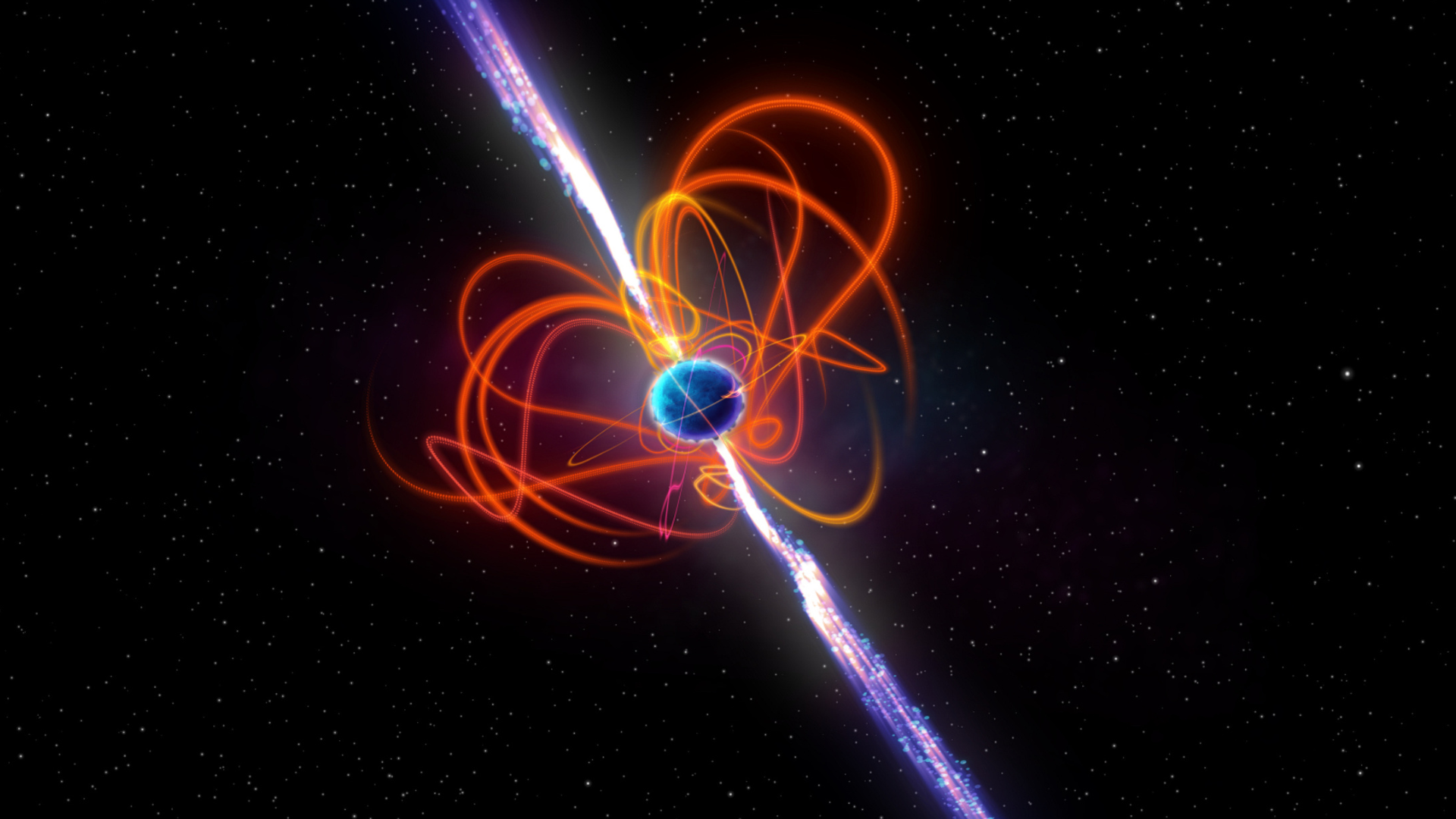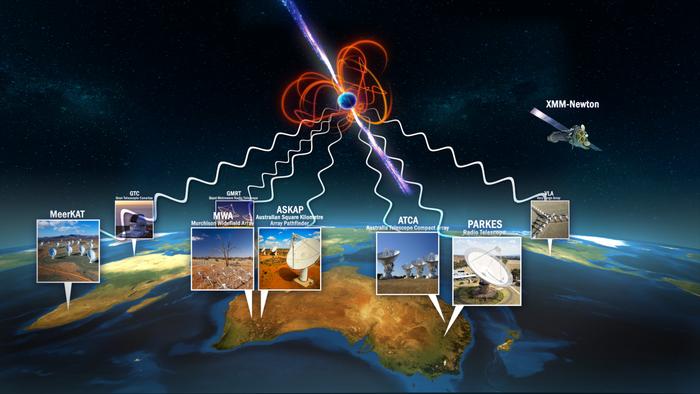Bizarre 'slow' neutron star challenges our theories about dead stars
'Assuming it's a magnetar, it shouldn't be possible for this object to produce radio waves. But we're seeing them.'

Astronomers have discovered a neutron star with an incredibly powerful magnetic field blasting out energy more slowly than any other ever seen.
The newfound object is a type of neutron star known as a magnetar. What makes this particular stellar remnant so extraordinary is that, while its siblings blast out energy at intervals ranging from a few seconds to a few minutes, this neutron star has a more leisurely schedule, emitting radio waves at 22-minute intervals.
This makes the magnetar — designated GPM J1839-10 and located 15,000 light-years from Earth in the Scutum constellation — the longest-period magnetar ever spotted. GPM J1839-10 also blasts out bursts of radiation that last five times as long as those of similar long-period magnetars.
"This remarkable object challenges our understanding of neutron stars and magnetars, which are some of the most exotic and extreme objects in the universe," research lead author Natasha Hurley-Walker, an astronomer at Curtin University in Australia, said in a statement.
Related: James Webb Space Telescope spots violent collision between neutron stars
Existence below the deathline makes these neutron stars even more extreme
Like all neutron stars, magnetars like GPM J1839-10 are created when massive stars reach the end of their lives. As they exhaust the fuel for nuclear fusion, the stars can no longer balance themselves against the inward force of their own gravity.
This results in their core collapsing and the outer layers of these stars being shed in massive supernova explosions. The collapse causes a stellar core with a mass around that of the sun to crush down to a width no greater than the diameter of around 12 miles (19 kilometers) — about the size of a city on Earth.
Get the Space.com Newsletter
Breaking space news, the latest updates on rocket launches, skywatching events and more!
This results in a stellar remnant with matter so dense that, if a tablespoon of it were brought to Earth, it would weigh an incredible 1 billion tons. The rapid diameter reduction causes the newly born neutron star to increase its rate of rotation, leading to it spinning as fast as 700 times a second. All of this is wrapped up in the most powerful magnetic fields in the universe, 10 trillion times more powerful than the magnetosphere of Earth. It’s little wonder neutron stars and magnetars are considered exotic.
Related: What are neutron stars?
Not all magnetars blast out radio waves or spin rapidly. As neutron stars age, they lose angular momentum and slow down, and their magnetic fields weaken. That means older magnetars have magnetic fields too weak to create high-energy emissions, with this threshold referred to as the "death line."
According to the team behind the new research, GPM J1839-10 is spinning slowly, indicating that it's an older magnetar and thus should have a magnetic field too weak to produce radio waves. In other words, it’s below the death line — yet it lives.
"Assuming it’s a magnetar, it shouldn’t be possible for this object to produce radio waves. But we’re seeing them. And we’re not just talking about a little blip of radio emission," Hurley-Walker said. "Every 22 minutes, it emits a five-minute pulse of radio wavelength energy, and it’s been doing that for at least 33 years. Whatever mechanism is behind this is extraordinary."
Not only does the very existence of GPM J1839-10 challenge scientists’ understanding of neutron stars, but it could mean this death-defying object represents an entirely new class of stellar remnants.
Life in the slow lane: Searching for long-period magnetars

GPM J1839-10 is the second "slow" magnetar discovered, with the previous example spotted by Curtin University undergraduate research student Tyrone O’Doherty.
Initially, even the team behind the first discovery was perplexed by their findings, describing the body as an enigmatic transient object that would intermittently appear and disappear as well as blasting out powerful beams of energy roughly three times per hour.
"We were stumped," Hurley-Walker explained. "So we started searching for similar objects to find out if it was an isolated event or just the tip of the iceberg."
Between July and September 2022, the team hunted the skies with the Murchison Widefield Array (MWA), a radio telescope in the outback of Western Australia. This search turned up GPM J1839-10.
The team followed up their research with observations conducted with three CSIRO (Commonwealth Scientific and Industrial Research Organisation) radio telescopes in Australia, the MeerKAT radio telescope in South Africa, the Grantecan (GTC) 10-meter telescope and Europe's XMM-Newton space telescope.
Once Hurley-Walker and colleagues had the coordinates of GPM J1839-10 pinned down, they set about scouring archival data from the world’s leading radio telescopes to see if the magnetar had been observed in the past.
"It showed up in observations by the Giant Metrewave Radio Telescope (GMRT) in India, and the Very Large Array (VLA) in the USA had observations dating as far back as 1988," the Curtin University researcher said. "That was quite an incredible moment for me. I was five years old when our telescopes first recorded pulses from this object, but no one noticed it, and it stayed hidden in the data for 33 years.
"They missed it because they hadn’t expected to find anything like it."
The team will continue to investigate GPM J1839-10, attempting to unlock its secrets, while continuing to search for more examples of slow magnetars.
The team’s research was published today (July 19) in the journal Nature.
Join our Space Forums to keep talking space on the latest missions, night sky and more! And if you have a news tip, correction or comment, let us know at: community@space.com.

Robert Lea is a science journalist in the U.K. whose articles have been published in Physics World, New Scientist, Astronomy Magazine, All About Space, Newsweek and ZME Science. He also writes about science communication for Elsevier and the European Journal of Physics. Rob holds a bachelor of science degree in physics and astronomy from the U.K.’s Open University. Follow him on Twitter @sciencef1rst.
-
Unclear Engineer Considering that the observational methods we use are poorly suited for finding things with this sort of repetition period, it isn't surprising that we don't have any theories to fit it. But, it seems like there are should be plenty of possibilities when you start including more than one body in the emission process. Maybe a companion star on an elliptical orbit, feeding/exciting a magnetar? Maybe this emitter is orbiting a black hole, and we are seeing lensing? Maybe it is a 3-body system. Maybe the emissions are coming form more than one of the bodies orbiting in the same tight system?Reply









